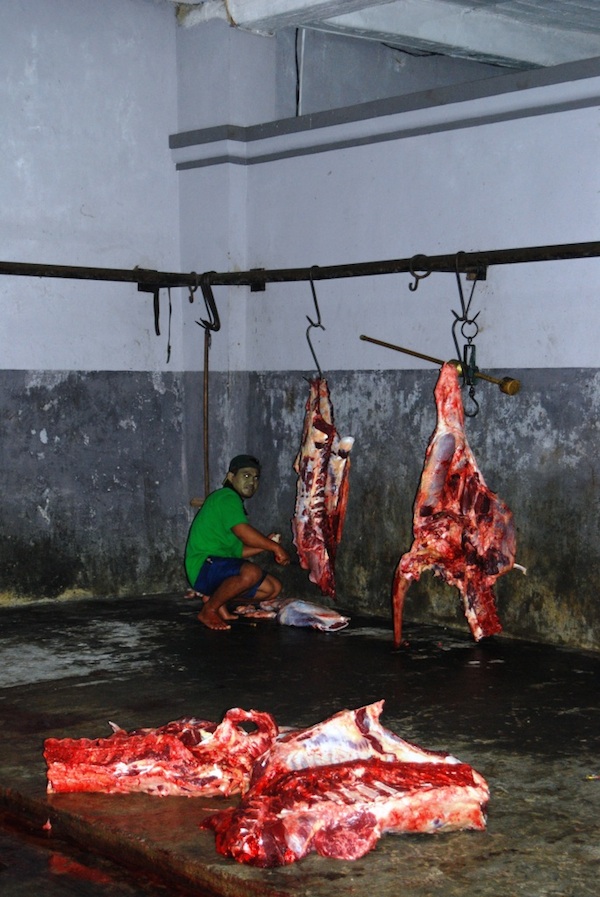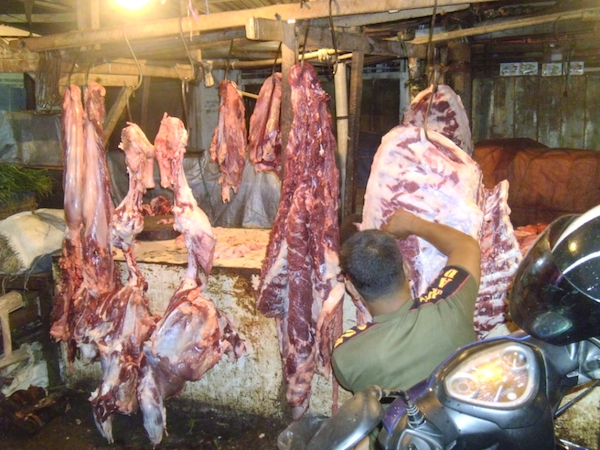From Abattoir to Wet Market
Host: Lisa Wood/ AGP Indonesia
Written by Lisa Wood – Traceability Officer, AGP.
**** WARNING – THIS POST CONTAINS PHOTOS OF THE BUTCHERING PROCESS. PLEASE DO NOT READ IF YOU ARE VERY SENSITIVE. THANK YOU****
At the time of writing this, I am inserting the photos along the way; having said that, I am leaving the final decision to Steph to edit the post to include the photos in sequence at the end. I understand that some people may be interested to read about the process, yet not to see it.
*Editors note – we have left the blog in its original format.
During my many visits to our supply chain abattoirs, I’ve often wondered about what happens after the butcher leaves the abattoir. One night on the way home, I stopped to buy some veggies and saw one of the butchers I had seen earlier at the abattoir setting up his stall at the wet market.
I thought it was a bit interesting and that maybe others would like to follow the trip too. Last time, I didn’t have my camera at the ready. Last week Nikki and Kurt from Country Downs Station came for a visit, so we took the opportunity to follow a butcher to his stall (You’ll be able to read more about their trip when Nikki does her posts). Having a day job, going out especially at 1am to follow an Indonesian butcher is not on my list of priorities. The photos included in this post are a mix of old and new.
Another interesting aspect of Indonesian abattoirs is that it is the abattoir owner who purchases the cattle from the feedlot to fill orders for butchers that will use his facility. At this abattoir, the name of the butcher is written next to ‘their’ animal on the Delivery docket. As the butcher arrives at the abattoir, his animal is identified in the yard and bought through the race to the stunning box. The butcher pays the abattoir owner for the cow they want to purchase, for transporting the cattle from the feedlot to the abattoir and for the use of the facility.
Last year I covered the trucking process from the feedlot to the abattoir, so I’m simply going to fast forward.
Our beast has been delivered from the feedlot to the abattoir. The cow has been stunned and slaughtered and the RFID scanned so we can report back to the Exporter. After waiting for the animal to bleed out, the Animal Welfare Officer to gives the word that the animal is dead and processing can begin.
As you can see, this happens on the ground. First the hocks (lower legs) are cut off then the gut slit of the skin is made. The back skin of the cow is left on for further down the processing track. The animal is gutted and all innards are removed and washed. Then it is quartered using an axe and knife. It’s at the quartering stage that the back skin is removed, rolling the carcass first to one side, and then the other, to finish dehiding.
As each process is finished, the separate parts are piled to the side of the work floor. When the processing is complete, each part is weighed and then loaded into a ute for the butcher to take to the wet market. The ute is not covered for the journey.

As you can see, every part of the cow is sent to market. The butcher who purchased the cow takes and sells every part. Nothing goes to waste.
A video Central Station editor Steph took whilst visiting Lisa in Indonesia in Dec 2012:
At this stage, we jumped in my car to follow the butcher to his stall at the market. It was about 1:30 in the morning.
We got to the market, parked, then proceeded to look for our butcher. The wet market is a surprisingly busy place at 2 o’clock in the morning. Some people have their stalls already open, others are still setting up. There are fresh vegetables that have come in from the villages having been picked the day before. There are chickens and fish – everything that a person could want to feed their family for the day.
The butcher and his assistant unload the ute and continue processing the carcass for the days sales.

The prices for the meat do not vary. It doesn’t matter what the cut of meat is. Prices do vary for the hocks, tongue, heart and tail. These are the ‘high demand’ parts.
No, I don’t buy my meat from the wet-market. I’m too much of a sook. I prefer to buy from the perceived safety of the supermarket where the meat is kept under refrigeration. In the event of an electricity outage, all supermarkets have backup generators.
After we finished bothering the stall owner with our questions we stopped to grab a bite to eat at the nearby Padang Restaurant. The special thing about eating at a Padang Restaurant is the way they bring out seven or more different dishes of small sized portions and you simply select which dish you want to eat and only pay for those you eat.
Kurt even gave the tendon/leg fat/skin dish a go. I’m not game enough to try that – I can’t even eat gristle, although I have tried fried cow skin before. It’s a bit like pork crackle. Unfortunately, being about 2:30 am, we forgot to take a photo as we were all too tired.
With the face of Indonesian processing slowly changing, I wonder at the future of selling meat this way. Yet knowing demand for electricity way exceeds the capacity to supply at this stage, that change is still a long way off.



